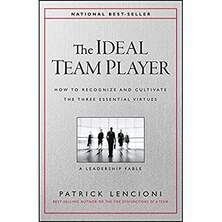Integrity, Courage, Respect, Excellence
Welcome!
Welcome to your ICRealtime customized resource page! As part of our commitment to excellence, we have created a special web page accessible only to ICRealtime where we will post content related to projects we are doing for you to further enhance and add value to your experience with us.
Current Projects
- Organizational Development
- Everything DiSC Sales Training
- Leadership Development
- Everything DiSC Workplace Training
Everything DiSC Sales Training
May We Suggest.....
This month's reading:

In his classic book, The Five Dysfunctions of a Team, Patrick Lencioni laid out a groundbreaking approach for tackling the perilous group behaviors that destroy teamwork. Here he turns his focus to the individual, revealing the three indispensable virtues of an ideal team player.
In The Ideal Team Player, Lencioni tells the story of Jeff Shanley, a leader desperate to save his uncle’s company by restoring its cultural commitment to teamwork. Jeff must crack the code on the virtues that real team players possess, and then build a culture of hiring and development around those virtues.
Beyond the fable, Lencioni presents a practical framework and actionable tools for identifying, hiring, and developing ideal team players. Whether you’re a leader trying to create a culture around teamwork, a staffing professional looking to hire real team players, or a team player wanting to improve yourself, this book will prove to be as useful as it is compelling.
To purchase The Ideal Team Player: https://www.amazon.com/Ideal-Team-Player-Recognize-Cultivate/dp/1119209595/ref=sr_1_1?ie=UTF8&qid=1546885385&sr=8-1&keywords=ideal+team+player
Resources
Values Integration
These videos will help you focus on one value per week. They explain what behaviors are connected to each value to make sure that everyone is moving in the same direction. In order to change behavior it is important that you really focus on one value per week instead of trying to work on them all at one time. Behavior change is made in small steps!
Integrity |
Courage |
|
|
|
Respect |
Excellence |
|
|
|
Reading
Conflict that Produces Results
10/2/2017
By Cindy Barber
President, The Dash Group

While most people associate the word conflict with something negative, it is critical to be able to have conflict on a team and in an organization. The best ideas or solutions to a problem come from situations where people with different perspectives and ideas are able to voice their opinions, respectfully
debate and work together to come to a solution.
Unfortunately, conflict can cause emotions to run high and before you know it, things can spin out of control and team members react rather than respond. We have all seen it and it can get ugly. Typically one of two things happen; either people get loud or passive aggressive or shut down completely. In either case, tension is high and results are low. So what can you do to have healthy conflict?
One thing we do with clients is to help them come up with what we call "Rules of Engagement". These are agreed upon rules that are posted on posters or poster-sized post-it notes in meetings to hold team members accountable for their behavior when conflict arises. These rules help temper emotions and allow for brilliant ideas and solutions to surface in meetings.
To come up with rules of engagement for a team, it is important to create this list in a meeting specifically for this task and not in the midst of a conflict crisis. We typically go around the room and ask each member of the team what they need to feel safe to voice their opinion in a conflict. Answers typically range from a guarantee of no retribution to no yelling to not calling out an individual in front of the group. The list always includes being respectful and making sure talk revolves around the "thing" and not any one person. Non-productive behavior like blaming is typically taken off the table.
When teams consistently adhere to their rules of engagement people are more likely to speak up, listen and consider other opinions. When that happens teams are actually brought closer by conflict and brilliant ideas are born.
debate and work together to come to a solution.
Unfortunately, conflict can cause emotions to run high and before you know it, things can spin out of control and team members react rather than respond. We have all seen it and it can get ugly. Typically one of two things happen; either people get loud or passive aggressive or shut down completely. In either case, tension is high and results are low. So what can you do to have healthy conflict?
One thing we do with clients is to help them come up with what we call "Rules of Engagement". These are agreed upon rules that are posted on posters or poster-sized post-it notes in meetings to hold team members accountable for their behavior when conflict arises. These rules help temper emotions and allow for brilliant ideas and solutions to surface in meetings.
To come up with rules of engagement for a team, it is important to create this list in a meeting specifically for this task and not in the midst of a conflict crisis. We typically go around the room and ask each member of the team what they need to feel safe to voice their opinion in a conflict. Answers typically range from a guarantee of no retribution to no yelling to not calling out an individual in front of the group. The list always includes being respectful and making sure talk revolves around the "thing" and not any one person. Non-productive behavior like blaming is typically taken off the table.
When teams consistently adhere to their rules of engagement people are more likely to speak up, listen and consider other opinions. When that happens teams are actually brought closer by conflict and brilliant ideas are born.

